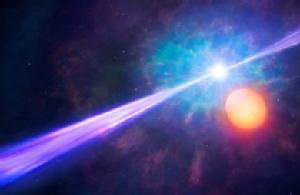Astronomy and Astrophysics Group
The Astronomy and Astrophysics group at Warwick is interested in a vast range of scales across the Universe: planetary systems, how they form, live and die; stars, stellar binaries and and the exotic physical processes that they allow us to explore; as well as the transient events which mark the end of stellar lifetimes and the galaxies stars inhabit across the Universe. The group started in September 2003 with the appointment of Prof Tom Marsh. We are both an observational and theoretical group, and we make use of a wide range of ground-based telescopes, such as ESO's Very Large Telescope (VLT)Link opens in a new window in Chile and the Isaac Newton GroupLink opens in a new window of telescopes (ING) in the Canary Islands, or the Atacama Large Millimetre Array (ALMA), as well as space telescopes such as NASA's ChandraLink opens in a new window and ESA's XMM-NewtonLink opens in a new window X-ray observatories and the Hubble Space TelescopeLink opens in a new window. We are partners in the four large spectroscopic surveys (DESI, SDSS-V, WEAVE, and 4MOST) that will start operations throughout 2021.
Many of the objects we study are dynamic and can change within minutes, seconds and even milli-seconds. We specialise in the high-speed data acquisition and analysis techniques needed to track them. Members of the group have contributed to the development and exploitation of the ULTRACAM high-speed photometer, the Wide Angle Search for PlanetsLink opens in a new window project (WASP), the Next Generation Transit SurveyLink opens in a new window (NGTS) and are actively hunting for the counterparts of GW transients with the Gravitational Wave Optical Transient Observer (GOTO) on La Palma. We are also heavily involved in the development of space missions including ESA's Exoplanet missions - PLATO (launch December 2026) and CHEOPS.
News
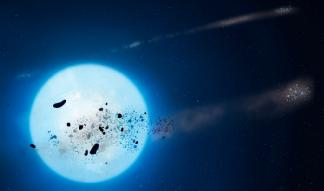 9 April 2024: Planetary systems survive the evolution of their host stars through into white dwarfs. Gravitationally interactions with planets can scatter smaller bodies onto an eccentric orbit, taking them deep into the gravitational potential of the white dwarf, where they get torn apart by tidal forces. If this debris passes along the line-of-sight from Earth, it will cause photometric transits. Astronomers from the University of Naresuan have studied three such systems using both high-speed photometry obtained with ULTRASPEC, which traces the detailed structure of the debris transits, as well as photometric observations from the CRTS, ASAS-SN, ATLAS and ZTF surveys, providing the long-term brightness changes of these system over the past 17 years. They found an astonishing variety of short- and long-term variability among the three systems. One system showing an overall dimming around 2012, indicating a catastrophic event that created so much dust and debris that it shrouded the white dwarf. In a second system, the deep and numerous transits detected around 2015 have gradually disappeared, and a third system shows irregular dimming events every couple of months, with no discernable period. This study demonstrates the complexity of the tidal disruption process, and subsequent circularisation of the debris. Learn more in the MNRAS paper and Warwick press release.
9 April 2024: Planetary systems survive the evolution of their host stars through into white dwarfs. Gravitationally interactions with planets can scatter smaller bodies onto an eccentric orbit, taking them deep into the gravitational potential of the white dwarf, where they get torn apart by tidal forces. If this debris passes along the line-of-sight from Earth, it will cause photometric transits. Astronomers from the University of Naresuan have studied three such systems using both high-speed photometry obtained with ULTRASPEC, which traces the detailed structure of the debris transits, as well as photometric observations from the CRTS, ASAS-SN, ATLAS and ZTF surveys, providing the long-term brightness changes of these system over the past 17 years. They found an astonishing variety of short- and long-term variability among the three systems. One system showing an overall dimming around 2012, indicating a catastrophic event that created so much dust and debris that it shrouded the white dwarf. In a second system, the deep and numerous transits detected around 2015 have gradually disappeared, and a third system shows irregular dimming events every couple of months, with no discernable period. This study demonstrates the complexity of the tidal disruption process, and subsequent circularisation of the debris. Learn more in the MNRAS paper and Warwick press release.
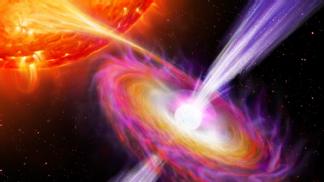 27 March 2024: In a first-ever experiment, a team of researchers, including Warwick Prize Fellow Dr Jakob van den Eijnden, have been able to measure the speed of a jet launched by a neutron star. Jets are powerful and fast gas streams that are seen across a range of objects in the universe, such as forming and exploding stars or supermassive black holes. How these jets are launched and how their properties connect to the object that launches them, remains an open question. In this new experiment, the team observed a neutron star as it gravitationally captured material from an orbiting companion star, before shooting a fraction of this gas away as a jet. Uniquely, the observations showed what happened to the jet when the neutron star showed a burst: an explosion on its surface that lasts a few seconds and increases the amount of fuel fed into the jet. Observing the jet respond to this brief impulse allowed the team to measure the jet’s speed at roughly 38% of the speed of light; incredibly fast, but only just fast enough to escape the neutron star’s powerful gravitational pull. Learn more in the Nature journal paper and the Warwick press release.
27 March 2024: In a first-ever experiment, a team of researchers, including Warwick Prize Fellow Dr Jakob van den Eijnden, have been able to measure the speed of a jet launched by a neutron star. Jets are powerful and fast gas streams that are seen across a range of objects in the universe, such as forming and exploding stars or supermassive black holes. How these jets are launched and how their properties connect to the object that launches them, remains an open question. In this new experiment, the team observed a neutron star as it gravitationally captured material from an orbiting companion star, before shooting a fraction of this gas away as a jet. Uniquely, the observations showed what happened to the jet when the neutron star showed a burst: an explosion on its surface that lasts a few seconds and increases the amount of fuel fed into the jet. Observing the jet respond to this brief impulse allowed the team to measure the jet’s speed at roughly 38% of the speed of light; incredibly fast, but only just fast enough to escape the neutron star’s powerful gravitational pull. Learn more in the Nature journal paper and the Warwick press release.
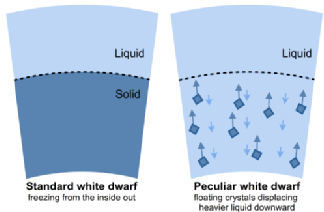 6 March 2024: Scientists have long considered that white dwarfs, having depleted their nuclear fuel, stop producing heat and cool down until the dense plasma in their interiors freezes into a solid from the inside out. A team co-led by Dr Antoine Bédard at the University of Warwick found that in some white dwarfs, the interior does not simply freeze from the inside out but instead, the solid crystals that are formed upon freezing are less dense than the liquid, and therefore want to float. As the crystals float upward, they displace the heavier liquid downward. The transport of heavier material toward the centre of the star releases gravitational energy, interrupting the star’s cooling process for billions of years. Learn more in the Nature journal paper and Warwick press release.
6 March 2024: Scientists have long considered that white dwarfs, having depleted their nuclear fuel, stop producing heat and cool down until the dense plasma in their interiors freezes into a solid from the inside out. A team co-led by Dr Antoine Bédard at the University of Warwick found that in some white dwarfs, the interior does not simply freeze from the inside out but instead, the solid crystals that are formed upon freezing are less dense than the liquid, and therefore want to float. As the crystals float upward, they displace the heavier liquid downward. The transport of heavier material toward the centre of the star releases gravitational energy, interrupting the star’s cooling process for billions of years. Learn more in the Nature journal paper and Warwick press release.
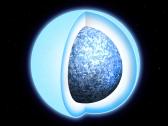 3 July 2023: Professor Boris Gänsicke talks about white dwarfs, the burnt out left-overs of the vast majority of all stars in the Milky Way, how they of key interest across a wide range of areas, including supernovae Ia and exo-planets, and discusses how the current and forthcoming state-of-the-art observational facilities revolutionise the research on white dwarfs. The interview was recorded at the annual meeting of the European Astronomical Society in Krakow, July 2023.
3 July 2023: Professor Boris Gänsicke talks about white dwarfs, the burnt out left-overs of the vast majority of all stars in the Milky Way, how they of key interest across a wide range of areas, including supernovae Ia and exo-planets, and discusses how the current and forthcoming state-of-the-art observational facilities revolutionise the research on white dwarfs. The interview was recorded at the annual meeting of the European Astronomical Society in Krakow, July 2023.
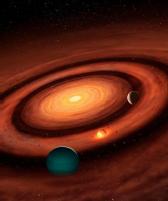 3 July 2023: Associate Professor and Dorothy Hodgkin Fellow, Farzana Meru, led a team to discover a new method of planet formation. Using computer simulations, the team showed how two large planets in the protoplanetary disc can potentially give rise to a smaller planet in between them – which they term “sandwiched planet formation”. What is also really interesting is that there are examples of exoplanet observations that actually show this sandwiched planet architecture — where the middle planet is less massive than its neighbours. Read the press release here.
3 July 2023: Associate Professor and Dorothy Hodgkin Fellow, Farzana Meru, led a team to discover a new method of planet formation. Using computer simulations, the team showed how two large planets in the protoplanetary disc can potentially give rise to a smaller planet in between them – which they term “sandwiched planet formation”. What is also really interesting is that there are examples of exoplanet observations that actually show this sandwiched planet architecture — where the middle planet is less massive than its neighbours. Read the press release here.
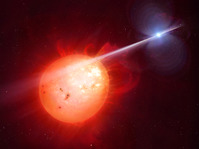 15th June 2023: Warwick Prize Fellow Ingrid Pelisoli led the discovery of a new white dwarf pulsar, only the second example of such a system to be found. The system, J191213.72-441045.1, is a binary composed of a white dwarf and an M-dwarf with an orbital period of 4.03 hours. The white dwarf is spinning with a period of only 5.3 minutes, sending a pulse of radiation covering radio to X-rays in our direction with each revolution. This discovery established white dwarf pulsars as a class, shedding light on the evolution of accreting binaries. The study was published in Nature AstronomyLink opens in a new window and featured in a press releaseLink opens in a new window.
15th June 2023: Warwick Prize Fellow Ingrid Pelisoli led the discovery of a new white dwarf pulsar, only the second example of such a system to be found. The system, J191213.72-441045.1, is a binary composed of a white dwarf and an M-dwarf with an orbital period of 4.03 hours. The white dwarf is spinning with a period of only 5.3 minutes, sending a pulse of radiation covering radio to X-rays in our direction with each revolution. This discovery established white dwarf pulsars as a class, shedding light on the evolution of accreting binaries. The study was published in Nature AstronomyLink opens in a new window and featured in a press releaseLink opens in a new window.
 5th November 2022: A team led by PhD researcher Abbigail Elms from the Warwick Astro group has identified the oldest star in our galaxy that is accreting debris from orbiting planetesimals, making it one of the oldest rocky and icy planetary systems discovered in the Milky Way. They have found the faintest and reddest white dwarf in the Solar neighourhood, hiding at only 28 pc from the Sun. The remains of its orbiting planetary system are over ten billion years old and have a mysterious lithium and potassium-rich composition. Read the press release and the paper.
5th November 2022: A team led by PhD researcher Abbigail Elms from the Warwick Astro group has identified the oldest star in our galaxy that is accreting debris from orbiting planetesimals, making it one of the oldest rocky and icy planetary systems discovered in the Milky Way. They have found the faintest and reddest white dwarf in the Solar neighourhood, hiding at only 28 pc from the Sun. The remains of its orbiting planetary system are over ten billion years old and have a mysterious lithium and potassium-rich composition. Read the press release and the paper.
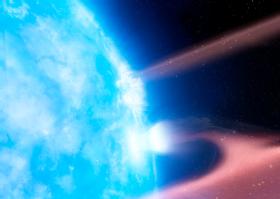 9th February 2022: The moment that debris from destroyed planets impact the surface of a white dwarf star has been observed for the first time by members of the Warwick Astro group. Until now, the inferred accretion rates and parent body compositions depended heavily on complex white dwarf envelope models. The new study was able to detect X-ray photons using the Chandra Space Telescope, deriving an instantaneous accretion rate which is independent of stellar atmosphere models, opening a new window to study the final instants of the life of rocky planets. The research led by Dr Tim Cunningham has been published in Nature.
9th February 2022: The moment that debris from destroyed planets impact the surface of a white dwarf star has been observed for the first time by members of the Warwick Astro group. Until now, the inferred accretion rates and parent body compositions depended heavily on complex white dwarf envelope models. The new study was able to detect X-ray photons using the Chandra Space Telescope, deriving an instantaneous accretion rate which is independent of stellar atmosphere models, opening a new window to study the final instants of the life of rocky planets. The research led by Dr Tim Cunningham has been published in Nature.
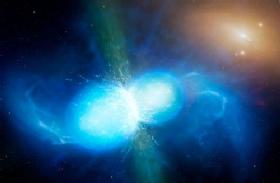 6th October 2021: We are excited to announce the Warwick prize scholarships and fellowships in astrophysics. Made possible thanks to a generous philanthropic donation from a Warwick alumnus, these awards enable us to support a pipeline of talent from postgraduate study up to early career researchers. The scheme has two components, scholarships that fully fund a 4 year PhD degree and post-doctoral fellowships aimed at early-career researchers. The first cohort of prize winners is expected to start in October '22, with the scheme looking to support several scholarships and fellowships each year.
6th October 2021: We are excited to announce the Warwick prize scholarships and fellowships in astrophysics. Made possible thanks to a generous philanthropic donation from a Warwick alumnus, these awards enable us to support a pipeline of talent from postgraduate study up to early career researchers. The scheme has two components, scholarships that fully fund a 4 year PhD degree and post-doctoral fellowships aimed at early-career researchers. The first cohort of prize winners is expected to start in October '22, with the scheme looking to support several scholarships and fellowships each year.
 1st October 2021: The Astronomy and Astrophysics group is excited to announce the appointment of Dr Deanne Coppejans as a new faculty staff member in the group. Dr Coppejans research looks at the formation and evolution of powerful jets in a wide-range of stellar systems, and the explosive deaths of stars. In particular, looking at what multi-wavelength observations, stretching from radio waves up to X-rays, can tell us about these exotic phenomena, in order to learn about physics at the extreme.
1st October 2021: The Astronomy and Astrophysics group is excited to announce the appointment of Dr Deanne Coppejans as a new faculty staff member in the group. Dr Coppejans research looks at the formation and evolution of powerful jets in a wide-range of stellar systems, and the explosive deaths of stars. In particular, looking at what multi-wavelength observations, stretching from radio waves up to X-rays, can tell us about these exotic phenomena, in order to learn about physics at the extreme.
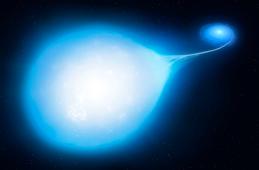 13th July 2021: Astronomers have made the rare sighting of two stars spiralling to their doom in the form of an eventual supernova that will consume both. Found by an international team of astronomers and astrophysicists led by Dr Ingrid Pelisoli at the University of Warwick, it is one of only very small number of star systems that has been discovered that will one day see a white dwarf star reignite its core. Read the press release and the paper in Nature Astronomy.
13th July 2021: Astronomers have made the rare sighting of two stars spiralling to their doom in the form of an eventual supernova that will consume both. Found by an international team of astronomers and astrophysicists led by Dr Ingrid Pelisoli at the University of Warwick, it is one of only very small number of star systems that has been discovered that will one day see a white dwarf star reignite its core. Read the press release and the paper in Nature Astronomy.
 4th May 2021: Prof. Boris Gänsicke has been awarded an European Research Council (ERC) Consolidator Grant worth over €2.5 million. Within this project, his team will study the final fate of planetary systems. The common fate of practically all stars hosting planets is that they will eventually evolve into white dwarfs - and large fractions of the planetary systems will survive this metamorphosis. For their research, the Warwick astronomers will make use of astrometric data from the ESA Gaia mission, spectroscopy from DESI, SDSS-V and WEAVE, and photometric observations to carry out an ambitious and comprehensive research program of white dwarfs hosting remnants of planetary systems, to find out more about the material accreting in these stars and to potentially identify new planets in close orbits around them.
4th May 2021: Prof. Boris Gänsicke has been awarded an European Research Council (ERC) Consolidator Grant worth over €2.5 million. Within this project, his team will study the final fate of planetary systems. The common fate of practically all stars hosting planets is that they will eventually evolve into white dwarfs - and large fractions of the planetary systems will survive this metamorphosis. For their research, the Warwick astronomers will make use of astrometric data from the ESA Gaia mission, spectroscopy from DESI, SDSS-V and WEAVE, and photometric observations to carry out an ambitious and comprehensive research program of white dwarfs hosting remnants of planetary systems, to find out more about the material accreting in these stars and to potentially identify new planets in close orbits around them.
 16th February 2021: To alleviate the cancellation of several in-person meetings on the topic of white dwarfs and related systems, a new seminar series has been created, the Online Meetings on Evolved Stars and Systems (O-MESS). Co-organised by Dr Ingrid Pelisoli, O-MESS aims at offering PhD students and non-permanent position holders a platform to promote their research. O-MESS will take place bi-weekly at 16:00 Central European Time (CET) on alternate Tuesdays and Wednesdays, providing a space for researchers around the world to get up-to-date on the newest findings in the field of white dwarfs, hot subdwarfs, central stars of planetary nebulae, and related systems. For more information, check the O-MESS website.
16th February 2021: To alleviate the cancellation of several in-person meetings on the topic of white dwarfs and related systems, a new seminar series has been created, the Online Meetings on Evolved Stars and Systems (O-MESS). Co-organised by Dr Ingrid Pelisoli, O-MESS aims at offering PhD students and non-permanent position holders a platform to promote their research. O-MESS will take place bi-weekly at 16:00 Central European Time (CET) on alternate Tuesdays and Wednesdays, providing a space for researchers around the world to get up-to-date on the newest findings in the field of white dwarfs, hot subdwarfs, central stars of planetary nebulae, and related systems. For more information, check the O-MESS website.
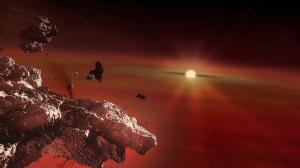 11th February 2021: Observations of lithium and potassium in the atmosphere of white dwarf stars provide the first definitive evidence of planetary crust formation in exoplanet systems. Lithium and potassium are good indicators of crust material as they are not present in high concentrations in the mantle or core. These crusts are from the outer layers of rocky planets similar to Earth and Mars and could provide us with greater insights into the chemistry of exoplanets, in this case some of the earliest formed in the Milky Way. The discovery led by Dr Mark Hollands is reported in Nature Astronomy.
11th February 2021: Observations of lithium and potassium in the atmosphere of white dwarf stars provide the first definitive evidence of planetary crust formation in exoplanet systems. Lithium and potassium are good indicators of crust material as they are not present in high concentrations in the mantle or core. These crusts are from the outer layers of rocky planets similar to Earth and Mars and could provide us with greater insights into the chemistry of exoplanets, in this case some of the earliest formed in the Milky Way. The discovery led by Dr Mark Hollands is reported in Nature Astronomy.
 9th December 2020: Dr Pier-Emmanuel Tremblay has been awarded a 2020 European Research Council (ERC) Consolidator Grant worth over €1.9 million. The funded project aims at transforming our understanding of the stellar neighbourhood within about 100 pc of the Sun, which contains the brightest, most easily visible specimens of almost all types of stars and planets, but remains poorly explored. Theoretical and observational development will be conducted to comprehend how white dwarfs and low-mass stars evolve, unlocking the enormous potential of using local stars as cosmic clocks to trace Milky Way formation history at much greater distances. The ERC funding will allow Dr Tremblay to build a team of experts that will be at the forefront of the stellar revolution triggered by the spacecraft Gaia of the European Space Agency and detailed spectroscopic follow-ups from 4MOST in Chile and WEAVE on La Palma in Spain.
9th December 2020: Dr Pier-Emmanuel Tremblay has been awarded a 2020 European Research Council (ERC) Consolidator Grant worth over €1.9 million. The funded project aims at transforming our understanding of the stellar neighbourhood within about 100 pc of the Sun, which contains the brightest, most easily visible specimens of almost all types of stars and planets, but remains poorly explored. Theoretical and observational development will be conducted to comprehend how white dwarfs and low-mass stars evolve, unlocking the enormous potential of using local stars as cosmic clocks to trace Milky Way formation history at much greater distances. The ERC funding will allow Dr Tremblay to build a team of experts that will be at the forefront of the stellar revolution triggered by the spacecraft Gaia of the European Space Agency and detailed spectroscopic follow-ups from 4MOST in Chile and WEAVE on La Palma in Spain.
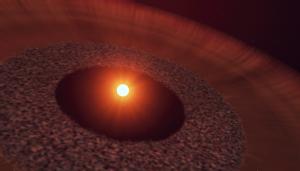 30th November 2020: A unique stage of planetary system evolution has been imaged by astronomers, including Grant Kennedy from the Warwick Astronomy and Astrophysics group. Fast-moving carbon monoxide gas is seen to be flowing away from a star system over 400 light years away, a discovery that provides an opportunity to study how our own solar system developed. Read our press release here.
30th November 2020: A unique stage of planetary system evolution has been imaged by astronomers, including Grant Kennedy from the Warwick Astronomy and Astrophysics group. Fast-moving carbon monoxide gas is seen to be flowing away from a star system over 400 light years away, a discovery that provides an opportunity to study how our own solar system developed. Read our press release here.
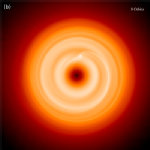 26th November 2020: Giant planets that developed early in a star system’s life could solve a mystery of why spiral structures are not observed in young protoplanetary discs, according to a new study led by our Sahl Rowther. The research, published in the Astrophysical Journal Letters and part supported by the Royal Society, provides an explanation for the lack of spiral structure that astronomers expect to see in protoplanetary discs around young stars. See the Warwick press release here.
26th November 2020: Giant planets that developed early in a star system’s life could solve a mystery of why spiral structures are not observed in young protoplanetary discs, according to a new study led by our Sahl Rowther. The research, published in the Astrophysical Journal Letters and part supported by the Royal Society, provides an explanation for the lack of spiral structure that astronomers expect to see in protoplanetary discs around young stars. See the Warwick press release here.
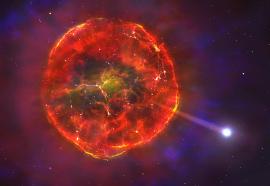 15th July 2020: Thermonuclear blast sends supernova survivor star hurtling across the Milky Way. An exploding white dwarf star blasted itself out of its orbit with another star in a ‘partial supernova’ and is now hurtling across our galaxy at 900 000km/h, according to a new study led by Boris Gänsicke from the Warwick Astronomy and Astrophysics group, published today in the Monthly Notices of the Royal Astronomical Society. It opens up the possibility of many more survivors of supernovae travelling undiscovered through the Milky Way, as well as other types of supernovae occurring in other galaxies that astronomers have never seen before. Have a look at the Warwick press release press releaseLink opens in a new window and the paper for free on arXiv.Link opens in a new window
15th July 2020: Thermonuclear blast sends supernova survivor star hurtling across the Milky Way. An exploding white dwarf star blasted itself out of its orbit with another star in a ‘partial supernova’ and is now hurtling across our galaxy at 900 000km/h, according to a new study led by Boris Gänsicke from the Warwick Astronomy and Astrophysics group, published today in the Monthly Notices of the Royal Astronomical Society. It opens up the possibility of many more survivors of supernovae travelling undiscovered through the Milky Way, as well as other types of supernovae occurring in other galaxies that astronomers have never seen before. Have a look at the Warwick press release press releaseLink opens in a new window and the paper for free on arXiv.Link opens in a new window
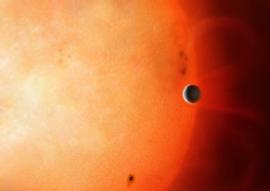 1st July 2020: The exposed core of a giant planet has been discovered revealing a dense Neptune-sized object with a mass 40 times that of the Earth. The surprising find hints at a violent past for the planet, with planetary impacts or tidal disruption required to remove the outer layers of atmosphere. The study led by Warwick astronomer Dr David Armstrong was published in NatureLink opens in a new window. See the Warwick press release here.
1st July 2020: The exposed core of a giant planet has been discovered revealing a dense Neptune-sized object with a mass 40 times that of the Earth. The surprising find hints at a violent past for the planet, with planetary impacts or tidal disruption required to remove the outer layers of atmosphere. The study led by Warwick astronomer Dr David Armstrong was published in NatureLink opens in a new window. See the Warwick press release here.
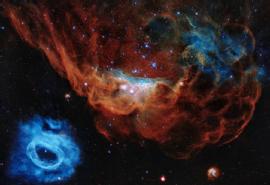 24th April 2020: Hubble turns thirty. On April 24th, 1990, the Hubble Space Telescope was launched onboard the space shuttle Discovery, and was deployed a day later into an orbit that takes it around the Earth once every 96 minutes. Located above the Earth's blurred atmosphere, Hubble has been taking countless stunningly beautiful pictures of planets, stars and galaxies that have kept us breathlessly admiring the beauty of space for the past three decades. Warwick is among Europe's most active Hubble users, and is celebrating this birthday.Link opens in a new window
24th April 2020: Hubble turns thirty. On April 24th, 1990, the Hubble Space Telescope was launched onboard the space shuttle Discovery, and was deployed a day later into an orbit that takes it around the Earth once every 96 minutes. Located above the Earth's blurred atmosphere, Hubble has been taking countless stunningly beautiful pictures of planets, stars and galaxies that have kept us breathlessly admiring the beauty of space for the past three decades. Warwick is among Europe's most active Hubble users, and is celebrating this birthday.Link opens in a new window
 23rd April 2020: Dr Joseph Lyman of the Astronomy and Astrophysics group is one of four Warwick academics to receive a highly-prestigious UKRI Future Leaders Fellowship in the third round of awards. Joe's project, titled "New frontiers in transient astrophysics: gravitational-wave multi-messenger events and exotic stellar explosions", is devoted to furthering our understanding of the changing night sky. See the Warwick press release here.
23rd April 2020: Dr Joseph Lyman of the Astronomy and Astrophysics group is one of four Warwick academics to receive a highly-prestigious UKRI Future Leaders Fellowship in the third round of awards. Joe's project, titled "New frontiers in transient astrophysics: gravitational-wave multi-messenger events and exotic stellar explosions", is devoted to furthering our understanding of the changing night sky. See the Warwick press release here.
 6th March 2020: A Warwick astronomer is amongst the first of the new UKRI Stephen Hawking Fellows announced today. We're delighted to be welcoming Dr Rebecca Nealon who is moving here from the University of Leicester to pursue her research on protoplanetary disks and how they impact the evolution of planets in solar systems outside our own. Rebecca’s simulations have a huge role to play in expanding our understanding of what might be possible elsewhere. Rebecca is also a great communicator who will exploit the focus on public engagement within the Stephen Hawking Fellowship, which we especially welcome, to promote science. The Stephen Hawking Fellowships were launched by UK Research and Innovation (UKRI), working with the Hawking family, in recognition of Stephen Hawking’s exceptional contributions to scientific knowledge and popularisation of science. See the Warwick press release here.
6th March 2020: A Warwick astronomer is amongst the first of the new UKRI Stephen Hawking Fellows announced today. We're delighted to be welcoming Dr Rebecca Nealon who is moving here from the University of Leicester to pursue her research on protoplanetary disks and how they impact the evolution of planets in solar systems outside our own. Rebecca’s simulations have a huge role to play in expanding our understanding of what might be possible elsewhere. Rebecca is also a great communicator who will exploit the focus on public engagement within the Stephen Hawking Fellowship, which we especially welcome, to promote science. The Stephen Hawking Fellowships were launched by UK Research and Innovation (UKRI), working with the Hawking family, in recognition of Stephen Hawking’s exceptional contributions to scientific knowledge and popularisation of science. See the Warwick press release here.
2nd March 2020: A massive white dwarf star with a bizarre, never seen before
hydrogen/carbon atmosphere could be two stellar remnants that merged
together. Less than 50 pc away, this is the first time that a merged white dwarf
has been identified using its atmospheric composition as a clue. This star is
useful in demonstrating how massive white dwarf mergers can get and still
survive without self-annihilation in supernovae Ia. This study led by Dr Mark Hollands has been published in Nature AstronomyLink opens in a new window, read the Warwick press release here.
2nd March 2020: Dr Farzana Meru from the astronomy and astrophysics group will be swapping simulations for legislation when she visits Matt Western MP at the Houses of Parliament and Whitehall for a week in Westminster. The week (1 – 5 March) is part of a unique pairing scheme run by the Royal Society—the UK’s national academy of science—with support from the Government Office of Science. The scheme allows scientists to learn how government works while at the same time spreading scientific literacy and insight. The Warwick press release can be read here.
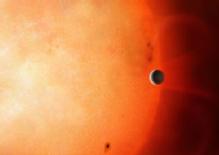 20th February 2020: Researchers from our NGTS team have identified an exoplanet on the edge of destruction. The new study, led by our James McCormac, has observed an exoplanet orbiting a star in just over 18 hours, the shortest orbital period ever observed for a planet of its type. It means that a single year for this hot Jupiter – a gas giant similar in size and composition to Jupiter in our own solar system – passes in less than a day of Earth time. Read our press release here.
20th February 2020: Researchers from our NGTS team have identified an exoplanet on the edge of destruction. The new study, led by our James McCormac, has observed an exoplanet orbiting a star in just over 18 hours, the shortest orbital period ever observed for a planet of its type. It means that a single year for this hot Jupiter – a gas giant similar in size and composition to Jupiter in our own solar system – passes in less than a day of Earth time. Read our press release here.

1st February 2020: The Astronomy and Astrophysics group is delighted to welcome Dr Heather Cegla as a new faculty member and UKRI Future Leaders Fellow. Dr Cegla’s work aims to push the frontiers of astronomy towards the future confirmation and characterisation of habitable alien worlds.
13th January 2020: New work from our Ashley Chrimes and Elizabeth Stanway has used cutting-edge models of stellar evolution to explore the potential progenitors of gamma ray bursts - the brightest explosions amongst the supernovae that end the lives of stars. They found that tidal influence from a binary companion can spin up the star which explodes, making gamma ray bursts more likely. The work is published in Monthly Notices of the Royal Astronomical Society and you can read the Warwick press release here.
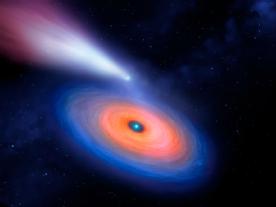 5th December 2019: The first giant planet orbiting a white dwarf has been discovered by Dr Boris Gänsicke and his colleagues. Using the Very Large Telescope of the European Southern Observatory, the authors of this study detected a large gaseous disc around the white dwarf, composed of hydrogen, oxygen and sulphur. This disc is formed from the atmosphere of a giant planet, probably similar to Uranus or Neptune that is evaporated by the intense extreme-ultraviolet radiation from the hot (28000K) white dwarf. This study has been published in NatureLink opens in a new window, read the Warwick press release here.
5th December 2019: The first giant planet orbiting a white dwarf has been discovered by Dr Boris Gänsicke and his colleagues. Using the Very Large Telescope of the European Southern Observatory, the authors of this study detected a large gaseous disc around the white dwarf, composed of hydrogen, oxygen and sulphur. This disc is formed from the atmosphere of a giant planet, probably similar to Uranus or Neptune that is evaporated by the intense extreme-ultraviolet radiation from the hot (28000K) white dwarf. This study has been published in NatureLink opens in a new window, read the Warwick press release here.
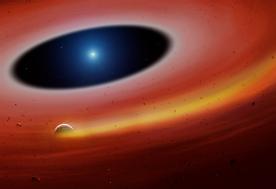 5th April 2019: An international team lead by Dr Christopher Manser has discovered a planetesimal on a 2 hour period orbiting a white dwarf using a new spectroscopic method. Published in the journal ScienceLink opens in a new window, the team has determined that the small body has either a high density and/or a large internal strength, like an iron-dominated planetary core fragment. The method developed in this project can be readily applied to a number of other white dwarf planetary systems, and will hopefully unveil the presence of planetesimals at these systems. The Warwick press release is hereLink opens in a new window.
5th April 2019: An international team lead by Dr Christopher Manser has discovered a planetesimal on a 2 hour period orbiting a white dwarf using a new spectroscopic method. Published in the journal ScienceLink opens in a new window, the team has determined that the small body has either a high density and/or a large internal strength, like an iron-dominated planetary core fragment. The method developed in this project can be readily applied to a number of other white dwarf planetary systems, and will hopefully unveil the presence of planetesimals at these systems. The Warwick press release is hereLink opens in a new window.
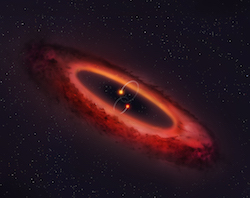 14 January 2019: Four stars, one circumbinary disk, four different orbital planes. A team led by Royal Society URF Dr Grant Kennedy has discovered an unusual orbital configuration for the circumbinary disk in the HD 98800 quadruple system. In this system the disk orbits one binary pair, but at right angles to the binary orbital plane. While such "polar circumbinary" disks have been posited to exist, this discovery marks the first observational evidence, and provides a hint that planets may be able to form on such orbits. The result is published in Nature Astronomy and the Warwick press release is here.
14 January 2019: Four stars, one circumbinary disk, four different orbital planes. A team led by Royal Society URF Dr Grant Kennedy has discovered an unusual orbital configuration for the circumbinary disk in the HD 98800 quadruple system. In this system the disk orbits one binary pair, but at right angles to the binary orbital plane. While such "polar circumbinary" disks have been posited to exist, this discovery marks the first observational evidence, and provides a hint that planets may be able to form on such orbits. The result is published in Nature Astronomy and the Warwick press release is here.
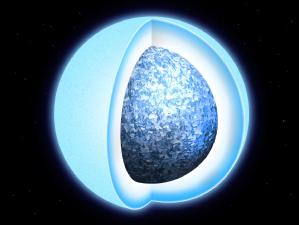 9 January 2019: Data captured by ESA’s galaxy-mapping spacecraft
9 January 2019: Data captured by ESA’s galaxy-mapping spacecraft
Gaia have revealed for the first time how white dwarfs, the dead
remnants of stars like our Sun, turn into solid carbon/oxygen spheres
as the hot gas inside them cools down. This process of solidification,
or crystallisation, of the material inside white dwarfs was predicted 50
years ago but it wasn’t until the arrival of Gaia that a Warwick team
lead by Dr Pier-Emmanuel Tremblay were able to observe enough of
these objects with such a precision to see the pattern revealing this
process. The result is published in Nature.
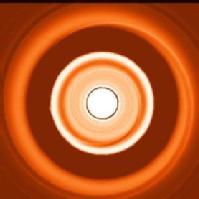 21st October 2018: New research by a team led by Dr Farzana Meru at the University of Warwick has a way of finally telling whether newly forming planets are migrating within the disc of dust and gas that typically surrounds stars or whether they are simply staying put in the same orbit around the star. Finding real evidence that a planet is migrating (usually inwards) within such discs would help solve a number of problems that have emerged as astronomers are able to see more and more detail within protoplanetary discs. In particular it might provide a simple explanation for a range of strange patterns and disturbances that astronomers are beginning to identify within these discs.
21st October 2018: New research by a team led by Dr Farzana Meru at the University of Warwick has a way of finally telling whether newly forming planets are migrating within the disc of dust and gas that typically surrounds stars or whether they are simply staying put in the same orbit around the star. Finding real evidence that a planet is migrating (usually inwards) within such discs would help solve a number of problems that have emerged as astronomers are able to see more and more detail within protoplanetary discs. In particular it might provide a simple explanation for a range of strange patterns and disturbances that astronomers are beginning to identify within these discs.

